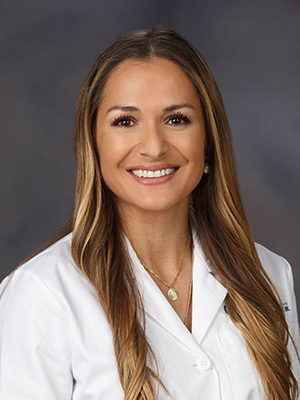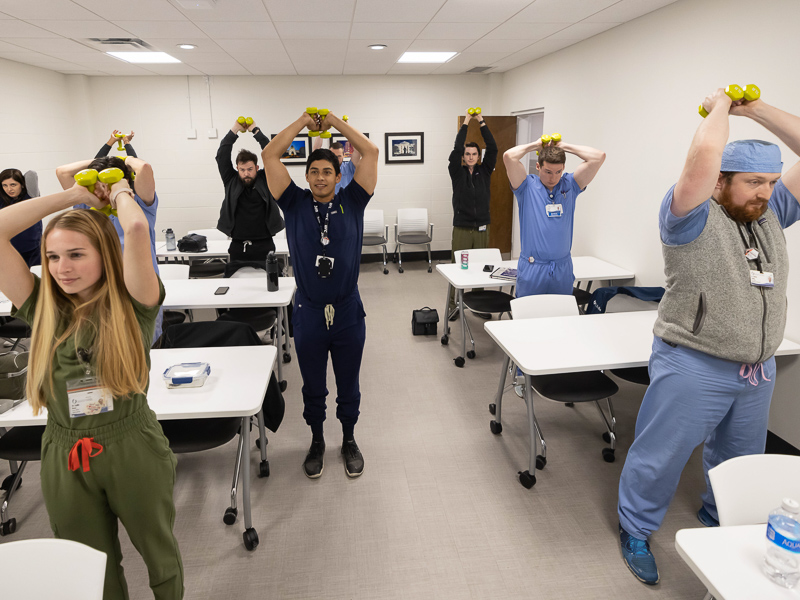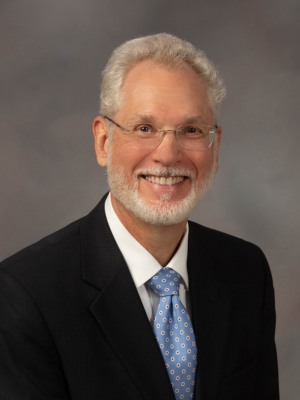Medical Center wellness programs lauded with Joy in Medicine award

Dr. Nilda Maria Williams loves working at the University of Mississippi Medical Center, loves her coworkers and loves the practice of radiology.
She finds joy in medicine – and wants to help others in UMMC’s health care family burdened by burnout and stress to love what they do, too.

“What is the best way to effect a culture change and for everyone to realize that wellness matters?” said Williams, an assistant professor in the Department of Radiology. “We are taking care of the sickest of the sick. We are a Level I trauma center. We have devoted our lives to medicine and sacrificed through the years.
“If our physicians are not well, how can we give the best care that we can to our patients?”
Through its Office of Well-being, the Medical Center has established the foundation for employees to find satisfaction and happiness in their workplace. The growing number of diverse initiatives from the Office of Well-being and its departmental partners has been recognized nationally by the American Medical Association with its Joy in Medicine Health System Recognition Program. Joy in Medicine guides organizations interested, committed or already engaged in improving physician satisfaction and reducing burnout.
The program is a nod to the AMA’s steadfast commitment to advancing the science of physician burnout and to propel health systems to reduce burnout so that physicians and their patients thrive. Recognition is awarded at the Bronze, Silver and Gold levels; UMMC and most of the total 71 institutions honored were designated Bronze and can qualify in the future for higher levels.

This year’s Bronze honorees include well-known academic health centers such as the Cleveland Clinic, Johns Hopkins Medicine, Mayo Clinic and Massachusetts General Physicians Organization.
The program’s objectives include providing a roadmap for health system leaders interested in actively supporting well-being, building a culture committed to increasing joy in medicine for the profession, and building understanding of solutions that promote joy in medicine and spur action to reduce physician burnout.
“This is a very positive affirmation of the work that UMMC has been doing,” said Dr. Josh Mann, chair of the Department of Preventive Medicine and director of the Office of Well-being.

“There’s definitely an awareness on the part of our leaders that we have to attend to the well-being of our team members,” Mann said. “It’s both for their benefit, and because we need to make sure people don’t throw in the towel and leave health care. We want them to be healthy and well and continue their careers.”
The 2021 Standpoint survey found that work-life balance struggles tied with compensation as top reasons faculty are considering leaving UMMC, Williams said. Twenty-eight percent of faculty replied that they are either “definitely burning out,” “symptoms of burnout won’t go away,” or they feel “completely burned out.”
An analysis at Stanford University concluded that if they did nothing for two years to address burnout, 60 physicians could leave at a cost of $15 million to $55 million, Williams said.
“There are physicians across the country who are not happy. They have given their lives to taking care of patients, and they are doing meaningful work,” said Williams, who chairs the Physician Wellness Subcommittee of the Medical Center’s Well-being Committee. “They are the most noble and incredible people, and they deserve to be happy.”
With its Bronze level designation, the AMA is recognizing and applauding UMMC’s steps to reduce physician burnout and stress and to promote the well-being of all employees. Among the many steps:
The Office of Well-being was created in 2018 to inspire a community where all members feel valued and experience well-being. It was born of a desire to address burnout and professional well-being among clinical faculty and staff and to create coalitions within the Medical Center to address issues that cause employee stress.
Everyday Wellness, established in 2016, is the health promotion arm of the Office of Well-being. It promotes healthy lifestyles and spiritual, financial, emotional and professional wellness.
The Resilience in Stressful Events (RISE) team is a peer response group formed in 2019 that is available around the clock to assist employees who are “second victims,” experiencing on-the-job stress that is potentially traumatic. Second victims can experience emotional or psychological stress, self-doubt, burnout and other problems that can cause personal anguish and hinder their ability to deliver safe, compassionate care.
The Office of Well-being is using a $3 million federal grant to offer all categories of health care workers new tools for support as they cope with challenges wrought by the pandemic and strive to regain their well-being. It includes anonymous online screening by mental health professionals for stress, depression and other mental health conditions and a personal response from a mental health counselor.
The Employee Assistance Program, which is free and confidential, is available to all students and employees. Services include up to three annual in-person, phone or video counseling sessions for issues such as relationships, workplace challenges, grief and loss, parenting, stress, anxiety, depression and addictions, allowing them talk via phone with trained professionals who can connect them with local professionals for face-to-face conversations. The program also assesses and refers for longer-term issues.
In the works, Mann said, is the addition of “3rd Conversation,” a collaboration with the Office of Patient Experience that brings together patients, patient families and clinicians to talk with each other about their experiences in health care. “It builds understanding,” Mann said. “They can work through issues and be on the same team.”
Making it all possible is help from all corners of the Medical Center, ranging from Human Resources to Epic to Faculty Affairs. The teams of Chief Medical Officer Dr. Michael Henderson and Chief Nursing Executive Dr. Kristina Cherry also are partners in well-being.

“One of the things I’m very proud of is that our senior leadership had the foresight to create an Office of Well-being,” said Dr. Patrick Smith, chief faculty affairs officer and a subcommittee member.
“The other thing I’m very proud of is the layers of effort that the Office of Well-being has put in place across the campus. They have reached out to lots of partners and collaborators to embed this in the workforce.”
Next steps as the Office of Well-being continues its Joy in Medicine journey, Smith said, include learning from the workforce what the gaps are in wellness programming, then creating a plan to address them.
Williams serves as her department’s wellness officer, quality and safety officer, and community outreach coordinator. She teaches and supports residents and is grateful for the support she receives from her colleagues.
She wants to spread her joy to others, and for those whose stress is causing burnout to get the help they need to experience well-being.
“These things put fire in my soul, make me excited to come to work every day, give me a sense of purpose and help me feel valued for the work I’m doing,” she said.


